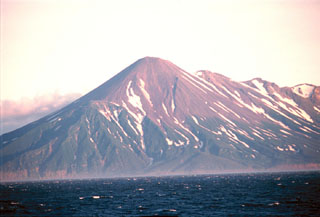Report on Chikurachki (Russia) — 23 July-29 July 2008
Smithsonian Institution / US Geological Survey
Weekly Volcanic Activity Report, 23 July-29 July 2008
Managing Editor: Sally Sennert.
Please cite this report as:
Global Volcanism Program, 2008. Report on Chikurachki (Russia) (Sennert, S, ed.). Weekly Volcanic Activity Report, 23 July-29 July 2008. Smithsonian Institution and US Geological Survey.
Chikurachki
Russia
50.324°N, 155.461°E; summit elev. 1781 m
All times are local (unless otherwise noted)
Based on observations of satellite imagery, KVERT reported that on 29 July an ash plume from Chikurachki drifted more than 30 km WSW. The level of seismicity was unknown because Chikurachki lacks dedicated seismic instruments. The Level of Concern Color Code was raised to Yellow.
Based on reports from KVERT, the Tokyo VAAC reported that on 29 July, an eruption plume rose to an altitude of 6.1 km (20,000 ft) a.s.l.
Geological Summary. Chikurachki, the highest volcano on Paramushir Island in the northern Kuriles, is a relatively small cone constructed on a high Pleistocene edifice. Oxidized basaltic-to-andesitic scoria deposits covering the upper part of the young cone give it a distinctive red color. Frequent basaltic Plinian eruptions have occurred during the Holocene. Lava flows have reached the sea and formed capes on the NW coast; several young lava flows are also present on the E flank beneath a scoria deposit. The Tatarinov group of six volcanic centers is located immediately to the south, and the Lomonosov cinder cone group, the source of an early Holocene lava flow that reached the saddle between it and Fuss Peak to the west, lies at the southern end of the N-S-trending Chikurachki-Tatarinov complex. In contrast to the frequently active Chikurachki, the Tatarinov centers are extensively modified by erosion and have a more complex structure. Tephrochronology gives evidence of an eruption around 1690 CE from Tatarinov, although its southern cone contains a sulfur-encrusted crater with fumaroles that were active along the margin of a crater lake until 1959.
Sources: Kamchatkan Volcanic Eruption Response Team (KVERT), Tokyo Volcanic Ash Advisory Center (VAAC)

